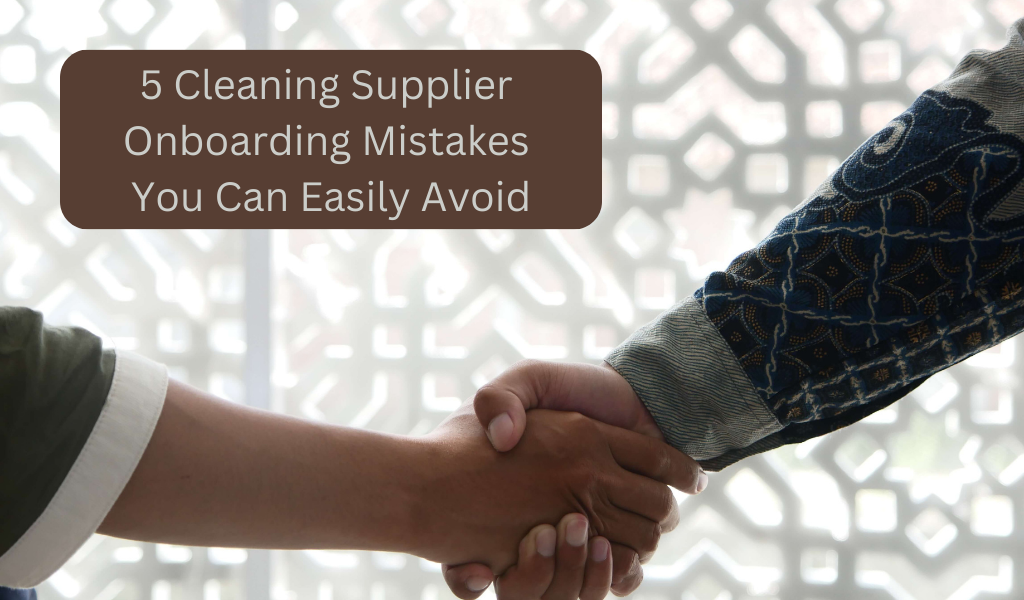Supplier onboarding, also known as vendor onboarding, can save you time and energy – unless you make these mistakes.
Part of a successful building services or commercial cleaning business is in developing relationships. This is evident with customers, but many of us don’t think about the relationships we build with our vendors and suppliers. Yet a strategic, thoughtful supplier onboarding process can help our business run more smoothly and efficiently.
Supplier onboarding isn’t necessarily complicated. And many of these processes start out informally, especially when our businesses are small. As things grow and expand, however, it’s helpful to develop a standard operating procedure (SOP) to streamline things.
As is the case with your customers, this process helps set expectations, ensure both parties are in agreement, and keep things organized. Additionally, a good onboarding process helps maintain consistency with different vendors across your organization, whether you have one location and a handful of suppliers or dozens of suppliers across entire regions.
Even though most supplier onboarding processes are relatively simple, there are some mistakes that are easy to make. Luckily, these mistakes are also easy to avoid if we know what to watch out for.
Keep up with your vendors, customers, staff, schedules, and checklists. Learn more today with a discovery call and find out how to make your cleaning operation more efficient, cost effective, and better for everyone!
5 Supplier onboarding mistakes you don’t want to make
1. Failing to vet your supplier. The very first supplier onboarding mistake is a potentially big one. You can bet many of your customers look at your online reviews before they contract with you. So why would you not look up your potential vendors?
As you know, a bad review or two isn’t a sign you need to avoid them. But you owe it to your business to at least check Yelp, Google, or other review sites to ensure you know something about this potential business partner. Take your time and ask around. There are different ways to vet potential suppliers. Take advantage of as much information as you can find.
2. Failing to notify your team. It happens. Everybody is busy and it’s easy to overlook the fact that you still need to tell your team about a new or different supplier. Then, one afternoon, your site supervisor orders supplies that won’t get delivered. Or a salesperson from the new vendor shows up, and no one knows who they are. We’ve all been there at one point. And we know how much confusion and delay this causes. But when you add this to your supplier onboarding checklist, you avoid this situation altogether.
3. Lack of clarity about your requirements. Your vendors supply you with cleaning products, supplies, technical help with software and apps, and plenty of other business needs. Some of your other vendors, however, may supply you with hiring or contracting services. For example, if you need temporary help from a contractor (vs. an employee), you may find that working with a staffing agency is a good way forward for your business.
At the same time, you still have specific skills or requirements that you need to meet. For example, if you need additional people in a school setting, you’ll need someone who has passed a background check. If your hard flooring specialist is out on vacation, you may need someone with similar certifications to fill in. It’s important to be clear and transparent about what your needs are, so the process goes smoothly.
4. Losing contracts and paperwork. As much as we’d like to avoid them, disputes happen. These may be simple, such as a discrepancy over a payment date. They could also be significant disputes, such as conflicts over expensive fees or missing orders. Staying organized can help when these issues arise. You can easily prevent some of these issues by filing your contracts, invoices, payments, and so forth. Make it part of your supplier onboarding to put a system or file in place for each vendor and each transaction. That information will also help you when you file taxes or make other business decisions.
5. Lack of planning. If part of supplier onboarding is getting organized, and another part is building the relationship, then the key to both of these is planning ahead. Specifically, plan ahead for ordering, equipment maintenance, scheduling contractors, and anything else that involves a vendor. There are a few reasons for this. To begin, when you plan ahead, you don’t run into emergencies that require premium payments.
But in terms of onboarding and keeping your relationship strong, planning ahead also results in fewer headaches for everyone. Last-minute requests are stressful and time-consuming for your vendors. Of course, emergencies happen. Everyone knows that. But continual requests for rush jobs break down your relationship with vendors.
It’s true that these aren’t all specifically supplier onboarding mistakes. Some of these are about your ongoing relationship. Still, when your onboarding process includes these considerations, you’re off to an excellent start.
Get labor and supply costs under control with powerful scheduling, workloading, and inventory tools. Get started now with a free call to Janitorial Manager to learn how mobile-friendly janitorial software can help you streamline your business.

